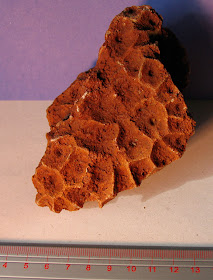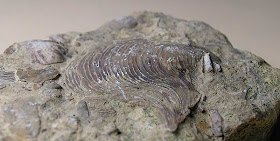
Pages
Sunday, May 31, 2009
Brachiopod Paraspirifer bownockeri and Spinocyrtia

Saturday, May 30, 2009
Devonian Plants in the New Albany Shale
I was not aware there were many fossils in the New Albany Shale layer and think of it as a time in the Middle Devonian period when the Louisville area was a dead water zone. It is thought that trees/plants drifted into this area from what is now Pennsylvania and New York.
I have found a number of papers on plants in the New Albany Shale layer when researching a question about the labeling of a plant fossil on the KYANA Geological Society website a while back.
The Structure and Classification of Four Plants From the New Albany Shale by J.H. Hoskins and A.T. Cross from American Midland Naturalist - November 1951. It says that four genera found in the black shales of the east central United States are: Callixylon, Asteroxylon, Protolepidodendron, and Reimannia.
Studies of New Albany Shale Plants. I. Stenokoleos Simplex Comb. by Charles B. Beck from American Journal of Botany - February 1960.
Studies of New Albany Shale. II. Callixylon Arnoldii by Charles B. Beck from Brittonia - October 15, 1962.
Studies of New Albany Shale. III. Chapelia Campbellii by Charles B. Beck from American Journal of Botany - September 1967.
Note splotches on some of the fossils is just water that has not yet evaporated after the rocks were cleaned. The pictures are of just two rocks each with fossil remains.

Friday, May 29, 2009
Silurian Coiled Cephalopod - Lituites marshi?



Thursday, May 28, 2009
Unknown Trilobite Cephalons and Pygidiums
Usually, I associate the brown/tan/reddish chert like rock with the Devonian period and the grey-white like rock with the Silurian period.
This first image the pygidium shows signs of being a forked posterior. A Devonian trilobite that had a forked posterior was the Coronura. The cephalon looks pointed so maybe this is a Silurian Trimerus.

Here is a closer view of the cephalon shown in the last picture. Again it might be a Trimerus.
Wednesday, May 27, 2009
A Dendrites Forest
Tuesday, May 26, 2009
Productella spinulicosta - Devonian Spiny Brachiopod
Here is a Devonian brachiopod a friend found on his visit to Louisville. It has 5 spines visible and is around 2 cm in diameter. It is sharing rock with several brachiopods and a horn coral.
It appears to be a Productella spinulicosta (Hall, 1867) in the Jeffersonville Limestone. Might also be known as Spinulicosta spinulicosta (how original).
According to this Kentucky Geological Survey page, the Jeffersonville Limestone is similar to the Onondaga Limestone of New York and the Grand Tower of Illinois (Savage, 1931).

Monday, May 25, 2009
Fossil Hunting on Memorial Day Weekend
 Large coral head embedded in the rock wall.
Large coral head embedded in the rock wall.Sunday, May 24, 2009
Turbinopsis shumardi or Pleuronotus decewi
I believe the Jeffersonville Limestone of Kentucky and Indiana corresponds to the Columbus Limestone in Ohio. The book describes "Pleuronotus decewi is a large, pseudoplanispirally coiled form that has sharp angulations forming the upper and lower margins of the whorls. It is also commonly preserved as an internal mold, which does not show the selenizone. The genus is restricted to the Devonian."
So maybe this snail could be the one described in the book? Ruler units are in centimeters.

Saturday, May 23, 2009
Devonian Coral: Hexagonaria
Friday, May 22, 2009
Indiana University Southeast Geoscience Department
Dr. Glenn Mason gave me a quick tour of their labs and displays. He was a friendly and enthusiastic professor with degrees from Purdue University, IUS, and University of Wyoming.
He allowed me to take some pictures of some sample in their cutting/polishing lab. Here are some polished corallites of possibly an Ordovician colonial coral.
 This is a picture of the outside of that coral. I liked that it still had intact septa showing, this can aid in its identification.
This is a picture of the outside of that coral. I liked that it still had intact septa showing, this can aid in its identification. Here is a polished Devonian coral.
Here is a polished Devonian coral.
Here is a polished cross section of another Devonian coral. I have adjusted the contrast to make the fossils stand out better.
There are a number of display cases outside in the hallway with minerals, gemstones, fossils, rocks and bones. Dr. Mason is looking for donations of more display cases so a larger portion of IUS collection can be displayed. He seemed especially interested in showing off more of the local corals and fossils that existed in the southern Indiana and Louisville, Kentucky area.
Just a note that residents of Louisville, Kentucky and Jefferson County, Kentucky and attend IUS put only pay Indiana in-state rates due to an agreement with Louisville schools (University of Louisville).
If there is enough interest, he offered to give KYANA Geological Society members a tour on some weekend.
Thursday, May 21, 2009
Fossils Found in Crawford County, Indiana - March 2008
Unknown trilobite pygidium found in the Indian Springs Shale of the Big Clifty Formation in Crawford County, Indiana.
UPDATE (2020/02/15): Maybe a Kaskia chesteriensis or Paladin chesteriensis.
 Unknown horn corals from the Mississippian period.
Unknown horn corals from the Mississippian period.UPDATE (2020/02/15): Maybe a Zaphrentites spinulosa or Amplexi zaphrentis?
Wednesday, May 20, 2009
Ordovician Clam: Caritodens demissa
The following pictures show an Ordovician period clam called Caritodens demissa (Conrad, 1842). This clam was found in eastern Jefferson County, Kentucky (just outside of Louisville, Kentucky). It was found in the Grant Lake Formation. Part of clam is still embedded in the rock matrix. The fossil is about 4 cm wide and 3.5 cm long. The Fossils of Ohio book says on page 139 this clam is common. It describes it as "a large species distinguished by auricles (large winglike extensions of the hinge), strongly developed comarginal ridges, and the lack of any radial ornamentation." A picture can be found in the book at Figure 12-1.1. Here is a link to another fossil found on the KYANA Geological Society website. This might be one at this link at the Kentucky Paleontological Society website. This link on the Dry Dredgers website shows a number of Caritoden pelecypods they have found. Learn more about this pelecypod fossil at one of my other postings.





























 Another polished cut slab of Devonian rock with a lot of corals in it.
Another polished cut slab of Devonian rock with a lot of corals in it.











